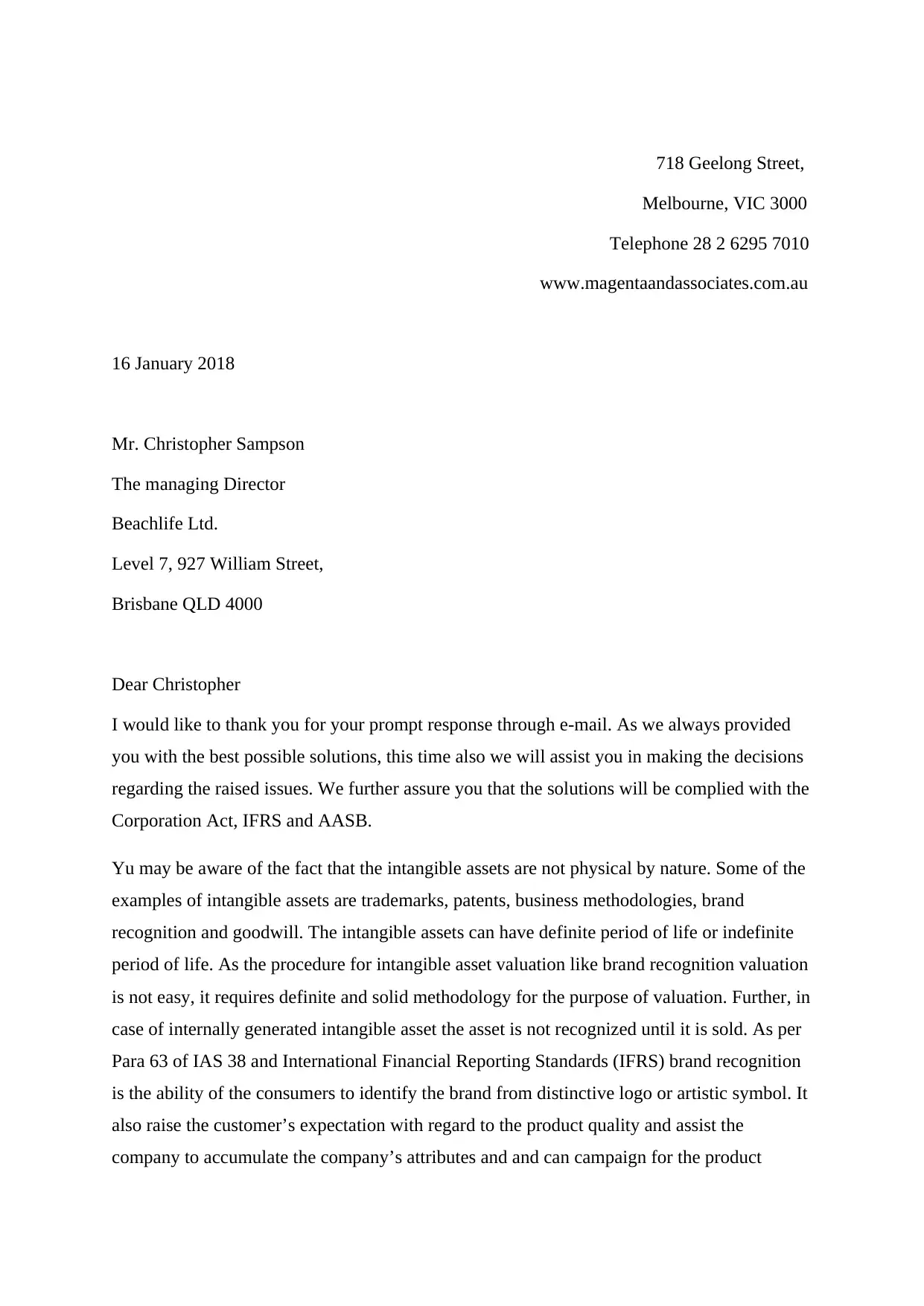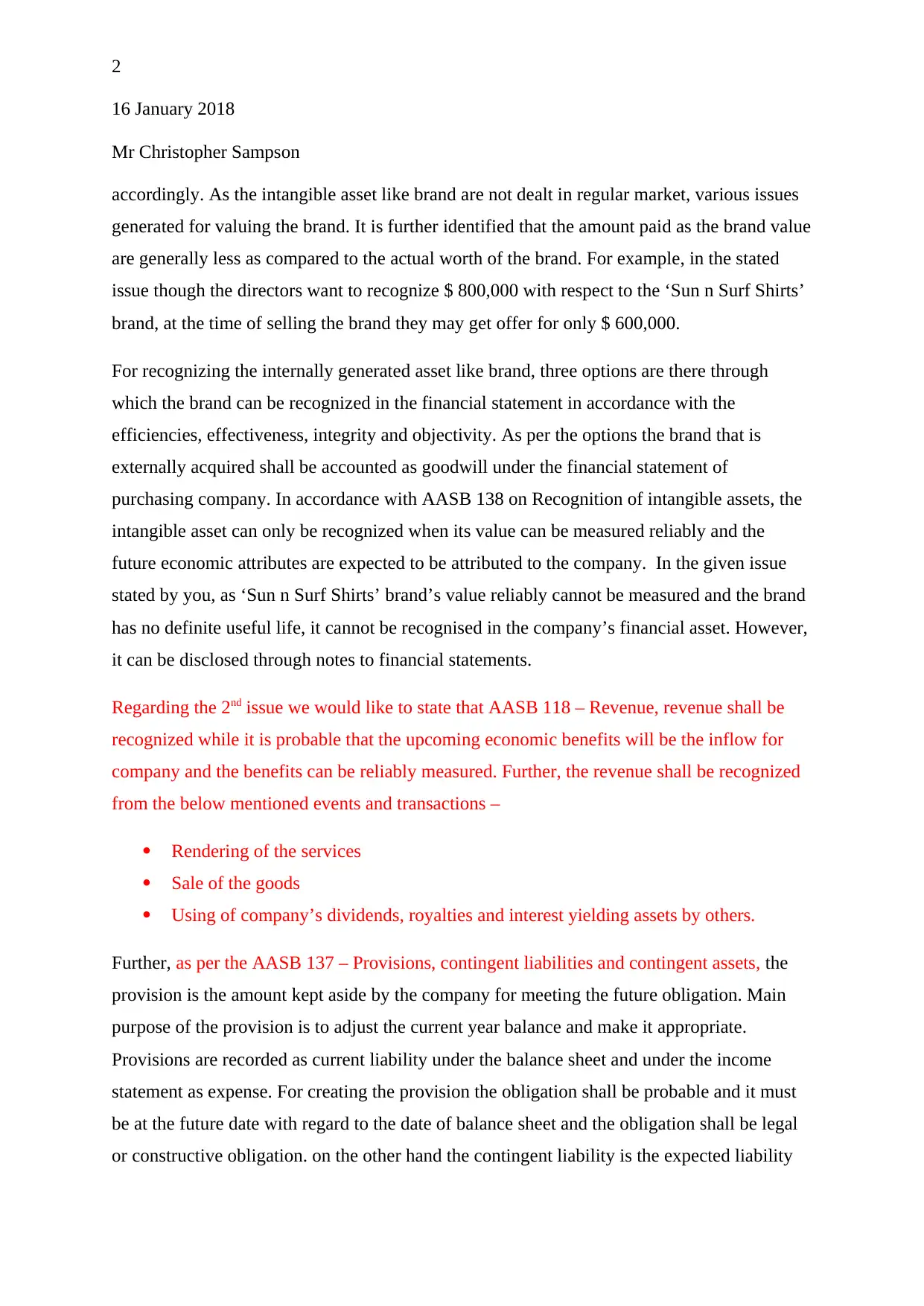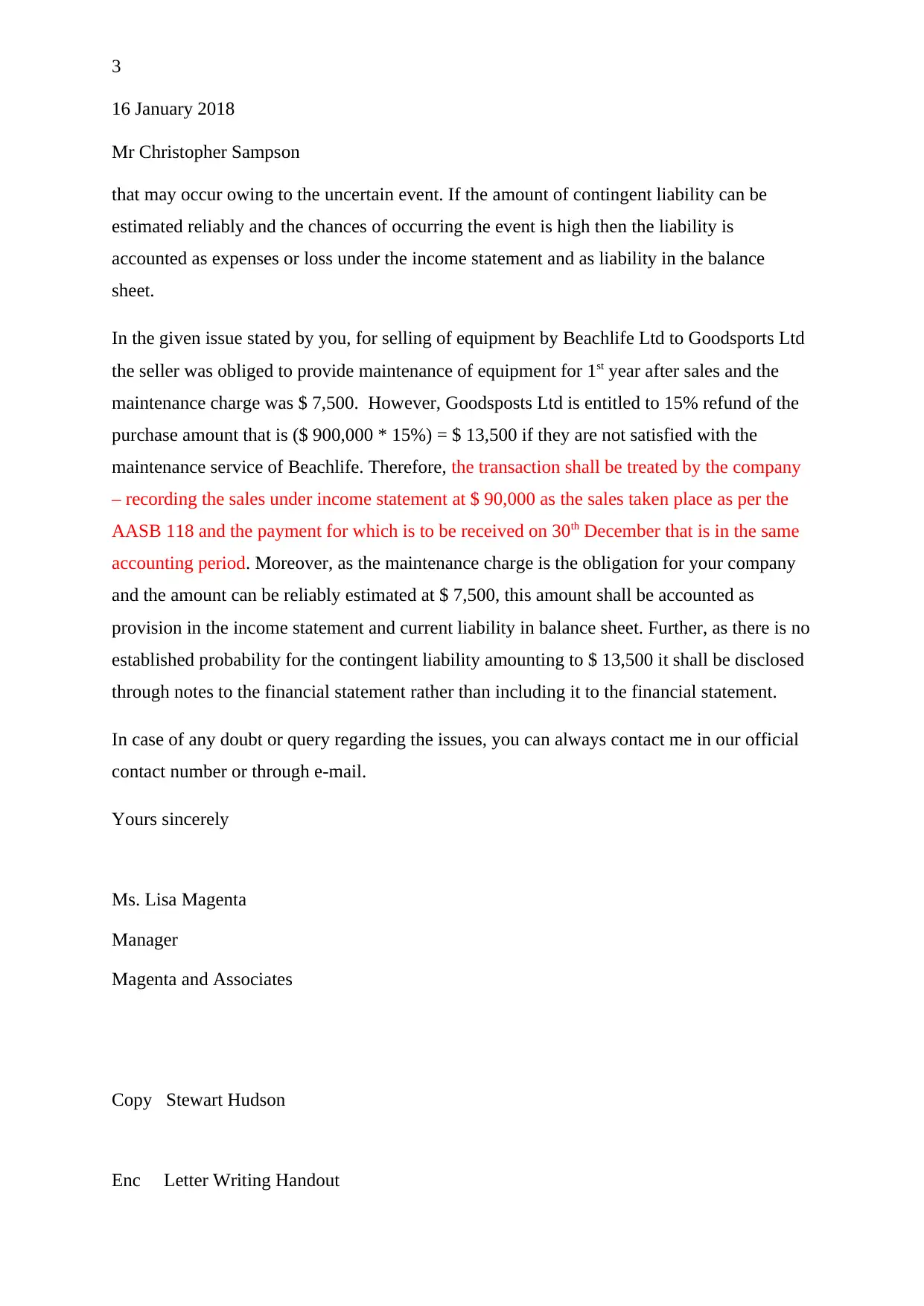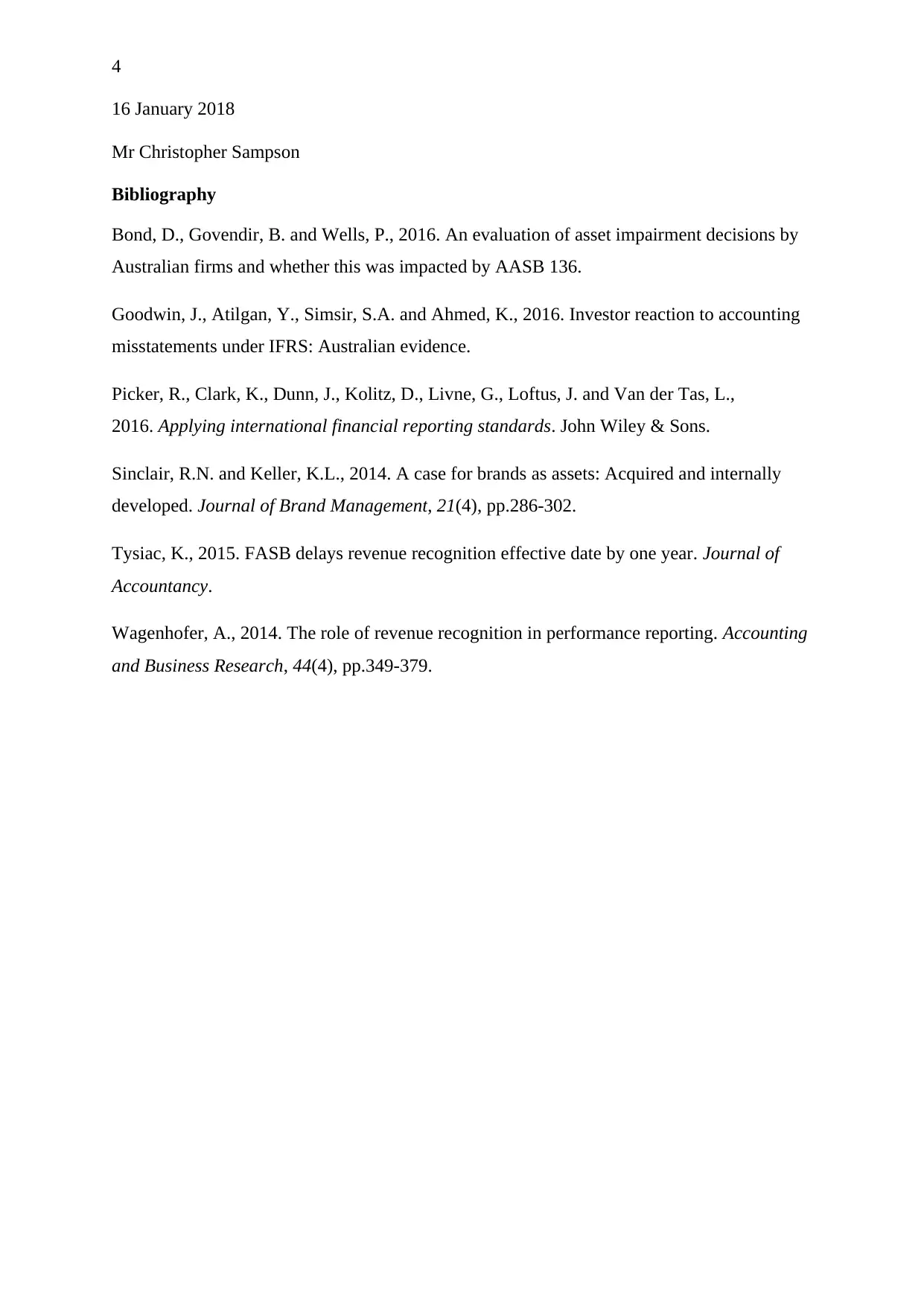Analysis of Financial Reporting Issues for Beachlife Ltd. (Finance)
VerifiedAdded on 2020/05/28
|4
|1188
|69
Report
AI Summary
This report analyzes financial reporting issues for Beachlife Ltd., addressing the recognition and valuation of intangible assets like brand recognition under IAS 38 and IFRS. It examines whether the company can recognize the value of the 'Sun n Surf Shirts' brand, considering the challenges in measuring its value reliably and the absence of a definite useful life. The report also addresses revenue recognition following AASB 118, specifically concerning the sale of goods and services, and how to account for provisions and contingent liabilities as per AASB 137. It provides guidance on recognizing revenue from equipment sales, including maintenance obligations and potential refunds, differentiating between provisions and contingent liabilities and their respective disclosures in financial statements. The analysis offers a comprehensive approach to financial reporting, ensuring compliance with accounting standards and providing insights for accurate financial statement presentation.

718 Geelong Street,
Melbourne, VIC 3000
Telephone 28 2 6295 7010
www.magentaandassociates.com.au
16 January 2018
Mr. Christopher Sampson
The managing Director
Beachlife Ltd.
Level 7, 927 William Street,
Brisbane QLD 4000
Dear Christopher
I would like to thank you for your prompt response through e-mail. As we always provided
you with the best possible solutions, this time also we will assist you in making the decisions
regarding the raised issues. We further assure you that the solutions will be complied with the
Corporation Act, IFRS and AASB.
Yu may be aware of the fact that the intangible assets are not physical by nature. Some of the
examples of intangible assets are trademarks, patents, business methodologies, brand
recognition and goodwill. The intangible assets can have definite period of life or indefinite
period of life. As the procedure for intangible asset valuation like brand recognition valuation
is not easy, it requires definite and solid methodology for the purpose of valuation. Further, in
case of internally generated intangible asset the asset is not recognized until it is sold. As per
Para 63 of IAS 38 and International Financial Reporting Standards (IFRS) brand recognition
is the ability of the consumers to identify the brand from distinctive logo or artistic symbol. It
also raise the customer’s expectation with regard to the product quality and assist the
company to accumulate the company’s attributes and and can campaign for the product
Melbourne, VIC 3000
Telephone 28 2 6295 7010
www.magentaandassociates.com.au
16 January 2018
Mr. Christopher Sampson
The managing Director
Beachlife Ltd.
Level 7, 927 William Street,
Brisbane QLD 4000
Dear Christopher
I would like to thank you for your prompt response through e-mail. As we always provided
you with the best possible solutions, this time also we will assist you in making the decisions
regarding the raised issues. We further assure you that the solutions will be complied with the
Corporation Act, IFRS and AASB.
Yu may be aware of the fact that the intangible assets are not physical by nature. Some of the
examples of intangible assets are trademarks, patents, business methodologies, brand
recognition and goodwill. The intangible assets can have definite period of life or indefinite
period of life. As the procedure for intangible asset valuation like brand recognition valuation
is not easy, it requires definite and solid methodology for the purpose of valuation. Further, in
case of internally generated intangible asset the asset is not recognized until it is sold. As per
Para 63 of IAS 38 and International Financial Reporting Standards (IFRS) brand recognition
is the ability of the consumers to identify the brand from distinctive logo or artistic symbol. It
also raise the customer’s expectation with regard to the product quality and assist the
company to accumulate the company’s attributes and and can campaign for the product
Paraphrase This Document
Need a fresh take? Get an instant paraphrase of this document with our AI Paraphraser

2
16 January 2018
Mr Christopher Sampson
accordingly. As the intangible asset like brand are not dealt in regular market, various issues
generated for valuing the brand. It is further identified that the amount paid as the brand value
are generally less as compared to the actual worth of the brand. For example, in the stated
issue though the directors want to recognize $ 800,000 with respect to the ‘Sun n Surf Shirts’
brand, at the time of selling the brand they may get offer for only $ 600,000.
For recognizing the internally generated asset like brand, three options are there through
which the brand can be recognized in the financial statement in accordance with the
efficiencies, effectiveness, integrity and objectivity. As per the options the brand that is
externally acquired shall be accounted as goodwill under the financial statement of
purchasing company. In accordance with AASB 138 on Recognition of intangible assets, the
intangible asset can only be recognized when its value can be measured reliably and the
future economic attributes are expected to be attributed to the company. In the given issue
stated by you, as ‘Sun n Surf Shirts’ brand’s value reliably cannot be measured and the brand
has no definite useful life, it cannot be recognised in the company’s financial asset. However,
it can be disclosed through notes to financial statements.
Regarding the 2nd issue we would like to state that AASB 118 – Revenue, revenue shall be
recognized while it is probable that the upcoming economic benefits will be the inflow for
company and the benefits can be reliably measured. Further, the revenue shall be recognized
from the below mentioned events and transactions –
Rendering of the services
Sale of the goods
Using of company’s dividends, royalties and interest yielding assets by others.
Further, as per the AASB 137 – Provisions, contingent liabilities and contingent assets, the
provision is the amount kept aside by the company for meeting the future obligation. Main
purpose of the provision is to adjust the current year balance and make it appropriate.
Provisions are recorded as current liability under the balance sheet and under the income
statement as expense. For creating the provision the obligation shall be probable and it must
be at the future date with regard to the date of balance sheet and the obligation shall be legal
or constructive obligation. on the other hand the contingent liability is the expected liability
16 January 2018
Mr Christopher Sampson
accordingly. As the intangible asset like brand are not dealt in regular market, various issues
generated for valuing the brand. It is further identified that the amount paid as the brand value
are generally less as compared to the actual worth of the brand. For example, in the stated
issue though the directors want to recognize $ 800,000 with respect to the ‘Sun n Surf Shirts’
brand, at the time of selling the brand they may get offer for only $ 600,000.
For recognizing the internally generated asset like brand, three options are there through
which the brand can be recognized in the financial statement in accordance with the
efficiencies, effectiveness, integrity and objectivity. As per the options the brand that is
externally acquired shall be accounted as goodwill under the financial statement of
purchasing company. In accordance with AASB 138 on Recognition of intangible assets, the
intangible asset can only be recognized when its value can be measured reliably and the
future economic attributes are expected to be attributed to the company. In the given issue
stated by you, as ‘Sun n Surf Shirts’ brand’s value reliably cannot be measured and the brand
has no definite useful life, it cannot be recognised in the company’s financial asset. However,
it can be disclosed through notes to financial statements.
Regarding the 2nd issue we would like to state that AASB 118 – Revenue, revenue shall be
recognized while it is probable that the upcoming economic benefits will be the inflow for
company and the benefits can be reliably measured. Further, the revenue shall be recognized
from the below mentioned events and transactions –
Rendering of the services
Sale of the goods
Using of company’s dividends, royalties and interest yielding assets by others.
Further, as per the AASB 137 – Provisions, contingent liabilities and contingent assets, the
provision is the amount kept aside by the company for meeting the future obligation. Main
purpose of the provision is to adjust the current year balance and make it appropriate.
Provisions are recorded as current liability under the balance sheet and under the income
statement as expense. For creating the provision the obligation shall be probable and it must
be at the future date with regard to the date of balance sheet and the obligation shall be legal
or constructive obligation. on the other hand the contingent liability is the expected liability

3
16 January 2018
Mr Christopher Sampson
that may occur owing to the uncertain event. If the amount of contingent liability can be
estimated reliably and the chances of occurring the event is high then the liability is
accounted as expenses or loss under the income statement and as liability in the balance
sheet.
In the given issue stated by you, for selling of equipment by Beachlife Ltd to Goodsports Ltd
the seller was obliged to provide maintenance of equipment for 1st year after sales and the
maintenance charge was $ 7,500. However, Goodsposts Ltd is entitled to 15% refund of the
purchase amount that is ($ 900,000 * 15%) = $ 13,500 if they are not satisfied with the
maintenance service of Beachlife. Therefore, the transaction shall be treated by the company
– recording the sales under income statement at $ 90,000 as the sales taken place as per the
AASB 118 and the payment for which is to be received on 30th December that is in the same
accounting period. Moreover, as the maintenance charge is the obligation for your company
and the amount can be reliably estimated at $ 7,500, this amount shall be accounted as
provision in the income statement and current liability in balance sheet. Further, as there is no
established probability for the contingent liability amounting to $ 13,500 it shall be disclosed
through notes to the financial statement rather than including it to the financial statement.
In case of any doubt or query regarding the issues, you can always contact me in our official
contact number or through e-mail.
Yours sincerely
Ms. Lisa Magenta
Manager
Magenta and Associates
Copy Stewart Hudson
Enc Letter Writing Handout
16 January 2018
Mr Christopher Sampson
that may occur owing to the uncertain event. If the amount of contingent liability can be
estimated reliably and the chances of occurring the event is high then the liability is
accounted as expenses or loss under the income statement and as liability in the balance
sheet.
In the given issue stated by you, for selling of equipment by Beachlife Ltd to Goodsports Ltd
the seller was obliged to provide maintenance of equipment for 1st year after sales and the
maintenance charge was $ 7,500. However, Goodsposts Ltd is entitled to 15% refund of the
purchase amount that is ($ 900,000 * 15%) = $ 13,500 if they are not satisfied with the
maintenance service of Beachlife. Therefore, the transaction shall be treated by the company
– recording the sales under income statement at $ 90,000 as the sales taken place as per the
AASB 118 and the payment for which is to be received on 30th December that is in the same
accounting period. Moreover, as the maintenance charge is the obligation for your company
and the amount can be reliably estimated at $ 7,500, this amount shall be accounted as
provision in the income statement and current liability in balance sheet. Further, as there is no
established probability for the contingent liability amounting to $ 13,500 it shall be disclosed
through notes to the financial statement rather than including it to the financial statement.
In case of any doubt or query regarding the issues, you can always contact me in our official
contact number or through e-mail.
Yours sincerely
Ms. Lisa Magenta
Manager
Magenta and Associates
Copy Stewart Hudson
Enc Letter Writing Handout
⊘ This is a preview!⊘
Do you want full access?
Subscribe today to unlock all pages.

Trusted by 1+ million students worldwide

4
16 January 2018
Mr Christopher Sampson
Bibliography
Bond, D., Govendir, B. and Wells, P., 2016. An evaluation of asset impairment decisions by
Australian firms and whether this was impacted by AASB 136.
Goodwin, J., Atilgan, Y., Simsir, S.A. and Ahmed, K., 2016. Investor reaction to accounting
misstatements under IFRS: Australian evidence.
Picker, R., Clark, K., Dunn, J., Kolitz, D., Livne, G., Loftus, J. and Van der Tas, L.,
2016. Applying international financial reporting standards. John Wiley & Sons.
Sinclair, R.N. and Keller, K.L., 2014. A case for brands as assets: Acquired and internally
developed. Journal of Brand Management, 21(4), pp.286-302.
Tysiac, K., 2015. FASB delays revenue recognition effective date by one year. Journal of
Accountancy.
Wagenhofer, A., 2014. The role of revenue recognition in performance reporting. Accounting
and Business Research, 44(4), pp.349-379.
16 January 2018
Mr Christopher Sampson
Bibliography
Bond, D., Govendir, B. and Wells, P., 2016. An evaluation of asset impairment decisions by
Australian firms and whether this was impacted by AASB 136.
Goodwin, J., Atilgan, Y., Simsir, S.A. and Ahmed, K., 2016. Investor reaction to accounting
misstatements under IFRS: Australian evidence.
Picker, R., Clark, K., Dunn, J., Kolitz, D., Livne, G., Loftus, J. and Van der Tas, L.,
2016. Applying international financial reporting standards. John Wiley & Sons.
Sinclair, R.N. and Keller, K.L., 2014. A case for brands as assets: Acquired and internally
developed. Journal of Brand Management, 21(4), pp.286-302.
Tysiac, K., 2015. FASB delays revenue recognition effective date by one year. Journal of
Accountancy.
Wagenhofer, A., 2014. The role of revenue recognition in performance reporting. Accounting
and Business Research, 44(4), pp.349-379.
1 out of 4
Related Documents
Your All-in-One AI-Powered Toolkit for Academic Success.
+13062052269
info@desklib.com
Available 24*7 on WhatsApp / Email
![[object Object]](/_next/static/media/star-bottom.7253800d.svg)
Unlock your academic potential
Copyright © 2020–2025 A2Z Services. All Rights Reserved. Developed and managed by ZUCOL.





